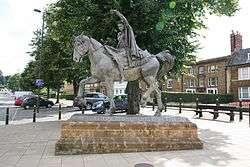Ride a cock horse to Banbury Cross
| "Ride a cock horse to Banbury Cross" | |
|---|---|
 The statue of the "fine lady" at Banbury Cross | |
| Nursery rhyme | |
| Published | 1784 |
| Songwriter(s) | Unknown |
"Ride a cock horse to Banbury Cross" is an English language nursery rhyme connected with the English town Banbury. It has a Roud Folk Song Index number of 21143.
Lyrics


Common modern versions include:
Ride a cock-horse to Banbury Cross,
To see a fine lady upon a white horse;
Rings on her fingers and bells on her toes,
And she shall have music wherever she goes.[2]
Alternative version:
Ride a cock-horse to Banbury Cross,
To buy little Johnny a galloping horse;
It trots behind and it ambles before,
And Johnny shall ride till he can ride no more.[3]
Origins
The modern rhyme is the best known of a number of verses beginning with the line "Ride a cock-horse to Banbury Cross", some of which are recorded earlier. These include a verse printed in Tommy Thumb's Pretty Song Book (c. 1744), with the lyrics:
Ride a cock-horse
To Banbury Cross,
To see what Tommy can buy;
A penny white loaf,
A penny white cake,
And a two-penny apple-pie.[2]
A reference in 1725 to 'Now on Cock-horse does he ride' may allude to this or the more famous rhyme, and is the earliest indication we have that they existed.[2] The earliest surviving version of the modern rhyme in Gammer Gurton's Garland or The Nursery Parnassus, printed in London in 1784, differs significantly from modern versions in that the subject is not a fine lady but "an old woman".[2] The version printed in Tommy Thumb's Song Book in America in 1788, which may have been in the original (c. 1744) edition, has the "fine lady", but the next extant version, in The Tom Tit's Song Book (printed in London around 1790), had:
A ring on her finger,
A bonnet of straw,
The strangest old woman
That ever you saw.[2]
Interpretations
The instability of the early recorded lyrics has not prevented considerable speculation about the meaning of the rhyme.
A medieval date had been argued for the rhyme on the grounds that the bells worn on the lady's toes refer to the fashion of wearing bells on the end of shoes in the fifteenth century, but given their absence from so many early versions, this identification is speculative.[2] Similarly, the main Banbury Cross was taken down around 1600, but other crosses were present in the town and, as is often the case, the place may have retained the name, so it is difficult to argue for the antiquity of the rhyme from this fact.[2]
A "cock horse" can mean a high-spirited horse, and the additional horse to assist pulling a cart or carriage up a hill. It can also mean an entire or uncastrated horse. From the mid-sixteenth century it also meant a pretend hobby horse or an adult's knee.[2]
Despite not being present or significantly different in many early versions, the fine lady has been associated with Queen Elizabeth I, Lady Godiva, and Celia Fiennes, whose brother was William Fiennes, 3rd Viscount Saye and Sele (c. 1641-1698) of Broughton Castle, Banbury, on the grounds that the line should be 'To see a Fiennes lady'. There is no corroborative evidence to support any of these cases.[2]
In popular culture
- The nursery rhyme was very popular before the twentieth century, and was sung every day by William Ewart Gladstone to his children as they had "rides on his foot, slung over his knee".[4]
- Lady Sheba (Jessie Wicker Bell) cited the nursery rhyme among folklore and poetry she believed to contain coded messages about Wicca devotions. The "Fine Lady" could be the Wiccan high priestess, or the Goddess she was said to embody.[5]
- Roger Daltrey of The Who released a solo album, Ride a Rock Horse, the cover of which featured the singer as a white centaur.
- In the 1970 film Five Easy Pieces, Bobby Dupea (Jack Nicholson) and Elton (Billy "Green" Bush) sing this rhyme with Shirley (Sally Ann Struthers) and Twinky (Marlena MacGuire) at about 15:30.
- In the 1973 movie Godspell, Jerry Sroka accidentally says “rings on his fingers and bells on his toes” instead of “rings on his fingers and shows on his feet” when telling the story of the Prodigal Son.
- In 1986, the rhyme played a role in a mystery on the American soap opera As The World Turns. The mystery centered around the eventual discovery of the character of Sabrina Fullerton, played at that time by future Oscar winning actress Julianne Moore.
- In the 2011 film Anonymous, Queen Elizabeth I can be heard singing the final lines of this song while dancing in her chamber.
References
- ↑ Project Gutenberg
- 1 2 3 4 5 6 7 8 9 I. Opie and P. Opie, The Oxford Dictionary of Nursery Rhymes (Oxford: Oxford University Press, 1951, 2nd edn., 1997), pp. 65-7.
- ↑ Eric and Lucy Kincaid, "Treasury of Nursery Rhymes" (Cambridge, England: Brimax Books, 1981), pp. 26.
- ↑ L. Masterman, ed., Mary Gladstone (Mrs. Drew): Her Diaries and Letters (London: Methuen, 1930), p. 4.
- ↑ Lady Sheba, The Witches' Workbook: The Magick Grimoire of Lady Sheba. Kensington, 1975.